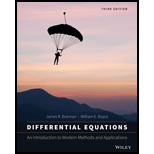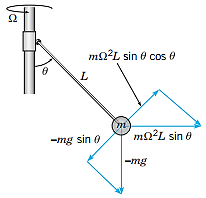
In the following problem, we ask the reader to some of the details left out of the above discussion, to analyse the closed-loop system for the stability properties, and to conduct a numerical simulation of the nonlinear system.
Work out the details leading toEq. (1).
The expression for
Answer to Problem 1P
Solution:
The expression for the angle between the fly ball connecting arm and the vertical shaft is:
Explanation of Solution
Given information:
The model for the fly ball governor follows from taking into account all of the forces acting on the fly ball and applying Newton’s law,

Explanation:
Let
By using the Newton’s second law of motion,
There are two forces acting on the point mass, one is gravity, which is in downward direction, so it is
The magnitude of the sum is easily found from the figure as
Also, for upward direction, the gravitational force is
Thus, the total magnitude of the sum is
But Newton’s second law of motion tells that the net force is the mass times the acceleration.
Let
Thus,
Therefore, the expression for the angle between the fly ball connecting arm and the vertical shaft is
Want to see more full solutions like this?
Chapter 5 Solutions
Differential Equations: An Introduction to Modern Methods and Applications
Additional Math Textbook Solutions
Mathematical Methods in the Physical Sciences
Introductory Mathematics for Engineering Applications
Calculus Volume 3
Mathematics with Applications In the Management, Natural, and Social Sciences (12th Edition)
Mathematics for Elementary Teachers with Activities (5th Edition)
Probability and Statistics for Engineers and Scientists
- Consider the system of linear equations in x and y. ax+by=ecx+dy=f Under what conditions will the system have exactly one solution?arrow_forwardACTIVITY 3 Direction: solve and analyze each of the following problem in neat and orderly manner. Do this in your indicated format. Determine the general solutions of the following non homogenous linear equations. 1. (D2 + D)y = sin x 2. (D2 - 4D+ 4)y = e* 3. (D2 - 3D + 2)y = 2x3-9x2 + 6x 4. (D2 + 4D+ 5)y 50x + 13e3x 5. (D3 - D2 + D- 1)y 4 sin x 6. (D3-D)y = x -END OF MODULE 3---arrow_forwardPart III Obtain the particular solutions of the following: d. y(2x* - xy + y* )dx –x (2x – y)dy =0,arrow_forward
- Love Affairs (Strogatz, Nonlinear Dynamics and Chaos, 1994) Let R(t) = Romeo's love/hate for Juliet at time t J(t) = Juliet's love/hate for Romeo at time t What happens when romantic opposites get together? A model for their romance is R = aJ j=-bR+aJ, a and b positive e. If 4b = a i. Write the general solution. ii. Classify the origin. iii. Summarize what happens in their relationship. (Hint: Think about the eigenvectors. Be sure to consider all the qualitatively different possibilities.)arrow_forwardInitially, two large tanks A and B each hold 100 gallons of brine. The well-stirred liquid is pumped between the tanks as shown in the figure below. Use the information given in the figure to construct a mathematical model for the number of pounds of salt x1(t) and x2(t) at time t, measured in minutes, in tanks A and B, respectively.arrow_forward12. (a) Find the solution(s) to the following system of linear equations: -3.r + 2y + 2z = 5, 4y + 4z = 3, -x - 2x + 4y = -2. (b) Let R be the region in the positive quadrant bounded by the straight lines 4.x, and by the hyperbolas xy = 1 and xy = 3. = 2x and (i) Sketch the region R (ii) Define parameters u = in the (u, v)-plane, corresponding to the region R in the (x, y)-plane. y/x and v = xy. Determine and sketch the region S (iii) Hence, using the given change of variables, evaluate the double integral TxY sin )dA. I = x2arrow_forward
 Linear Algebra: A Modern IntroductionAlgebraISBN:9781285463247Author:David PoolePublisher:Cengage Learning
Linear Algebra: A Modern IntroductionAlgebraISBN:9781285463247Author:David PoolePublisher:Cengage Learning Calculus For The Life SciencesCalculusISBN:9780321964038Author:GREENWELL, Raymond N., RITCHEY, Nathan P., Lial, Margaret L.Publisher:Pearson Addison Wesley,
Calculus For The Life SciencesCalculusISBN:9780321964038Author:GREENWELL, Raymond N., RITCHEY, Nathan P., Lial, Margaret L.Publisher:Pearson Addison Wesley, Elementary Linear Algebra (MindTap Course List)AlgebraISBN:9781305658004Author:Ron LarsonPublisher:Cengage Learning
Elementary Linear Algebra (MindTap Course List)AlgebraISBN:9781305658004Author:Ron LarsonPublisher:Cengage Learning Algebra for College StudentsAlgebraISBN:9781285195780Author:Jerome E. Kaufmann, Karen L. SchwittersPublisher:Cengage LearningAlgebra & Trigonometry with Analytic GeometryAlgebraISBN:9781133382119Author:SwokowskiPublisher:Cengage
Algebra for College StudentsAlgebraISBN:9781285195780Author:Jerome E. Kaufmann, Karen L. SchwittersPublisher:Cengage LearningAlgebra & Trigonometry with Analytic GeometryAlgebraISBN:9781133382119Author:SwokowskiPublisher:Cengage




